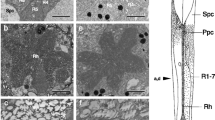Abstract
Y-tube tests of phototactic behavior of house flies (Musca domestica L.) involving wild-type, yellow-eyed, and hybrid individuals were conducted under low (8 ft-candles, 86.1 lux) and high (1600 ft-candles, 17,222.8 lux) light intensities. The Y-tube design utilized either a clear or a dark stem leading to the branches where the photochoice was made. No significant differences were found in the responses of the wild-type and hybrid lines to either light intensity or Y-tube design. Significant differences were recorded for the yellow-eyed individuals only under high light intensities, whereas their behavior under low light conditions was indistinguishable from that of the wild phenotypes. Yellow-eyed flies showed a 68.6% photopositive response when tested in dark-stemmed Y-tubes under 1600 ft-candles intensity as compared to the 86.0% and 83.3% photopositive responses of the wild and hybrid lines, respectively. However, the yellow-eyed flies tested in the clear-stemmed Y-tubes under 1600 ft-candles showed only a 28.7% photopositive response—a clear reversal toward photonegativity. Light-dark adaptation of the highly sensitive yellow-pigmented eye while in the stem of the Y-tube is responsible for this switch toward photonegative behavior.
Similar content being viewed by others
References
Benzer, S. (1967). Behavioral mutants ofDrosophila isolated by counter-current distribution.Proc. Natl. Acad. Sci. 58:1112–1119.
Berthold, R., and Benton, A. W. (1970). Honey bee photoresponse as influenced by age. Part I. Workers.Ann. Entomol. Soc. Am. 63:136–139.
Brown, F. A., and Hall, V. A. (1936). The directional influence of light uponDrosophila melanogaster Meig. and some of its eye mutants.J. Exp. Zool. 74:205–220.
Carpenter, F. W. (1905). The reactions of the pomace fly (Drosophila ampleophila Loew) to light, gravity, and mechanical stimulationAm. Naturalist 39:157–171.
Chabora, P. C. (1969). Mutant genes and the emigration behavior ofPhaenicia sericata.Evolution 23:65–71.
Chabora, P. C. (1977). Genetic and visual components affecting mating in the house fly,Musca domestica. Submitted for publication.
Chabora, P. C., and Kessler, M. E. (1977). Light intensity effects on the activity and emigratory behavior of the house fly,Musca domestica. Behav. Genet. (submitted).
Dobzhansky, T., and Spassky, B. (1967). Effects of selection and migration on geotactic and phototactic behavior ofDrosophila.Proc. Roy. Soc. Lond. Ser. B 168:27–47.
Dobzhansky, T., Spassky, B., and Sved, J. (1969). Effects of selection and migration on geotactic and phototactic behavior ofDrosophila. II.Proc. Roy. Soc. Lond. Ser. B 173:191–207.
Fingerman, M. (1952). The role of eye pigment ofDrosophila melanogaster in photic orientation.J. Exp. Zool. 120:131–164.
Grossfield, J. (1972). The use of behavioral mutants in biological control.Behav. Genet. 2:311–319.
Hadler, N. N. (1964a). Genetic influence on phototaxis inDrosophila melanogaster, Biol. Bull. 126:264–273.
Hadler, N. N. (1964b). Heritability and phototaxis inDrosophila melanogaster.Genetics 50:1269–1277.
Hansens, E. J., and Valiela, I. (1967). Activity of the face fly in New Jersey.J. Econ. Entomol. 60:21–28.
Hirsch, J. (1962). Individual differences in behavior and their genetic basis. In Bliss, E. L. (ed.),Roots of Behavior, Hoeber, New York.
Hirsch, J., and Boudreau, H. (1958). Studies in experimental behavior genetics. I. The heritability of phototaxis in a population ofDrosophila melanogaster, J. Comp. Physiol. Psychol. 51:647–651.
Horridge, G. A. (1975).The Compound Eye and Vision in Insects, Clarendon Press, Oxford.
Kirschfeld, K., and Franceschini, N. (1969). Ein Mechanismus zur Steuerung des Lichtflusses in den Rabdomeren des Komplexauges vonMusca.Kybernetik 6:13–22.
Knipling, E. F. (1972). Sterilization and other genetic techniques. InPest Control: Strategies for the Future, National Academy of Science, Washington, D.C., pp. 272–287.
Mazokhin-Porshnyakov, G. A. (1969).Insect Vision, Plenum, New York.
McCann, G. D., and MacGinitie, G. F. (1965). Optomotor response studies of insect vision.Proc. Roy. Soc. Lond. Ser. B 163:369–401.
Pak, W., Grossfield, J., and White, N. (1969). Nonphototactic mutants in a study of vision ofDrosophila, Nature 222:351–354.
Pimentel, D., Nagel, W. P., and Madden, J. L. (1963). Space-time structure of the environment and the survival of parasite-host systems.Am. Naturalist 97:141–167.
Pittendrigh, C. A. (1958). Adaptation, natural selection, and behavior. In: Roe, A., and Simpson, G. G. (eds.),Behavior and Evolution, Yale University Press, New Haven, pp. 390–416.
Richmond, R. O. (1969). Heritability of phototactic and geotactic responses inDrosophila pseudoobscura.Am. naturalist 103:315–316.
Rockwell, R. F., and Seiger, M. B. (1973). Phototaxis inDrosophila: A critical evaluation.Am. Scientist 61:339–345.
Streck, P. (1972). Screening pigment and visual field of single retinula cells ofCalliphora. In Wehner, R. (ed.),Information Processing in the Visual System of Arthropods, Springer-Verlag, New York, pp. 128–131.
Waddington, C. H., Woolf, H. G., and Perry, M. (1954). Environmental selection byDrosophila mutants.Evolution 8:89–96.
Walcott, B. (1975). Anatomical changes during light-adaptation in insect compound eyes. In Horridge, G. A. (ed.),The Compound Eye and Vision in Insects, Clarendon Press, Oxford, pp. 20–33.
Walton, P. D. (1970). The genetics of phototaxis inDrosophila melanogaster, Can. J. Genet. Cytol. 12:283–287.
Wehner, R. (ed.) (1972).Information Processing in the Visual System of Arthropods, Springer-Verlag, New York.
Whitten, M. J. (1970). Genetics of pests in their management. In Rabb, R. L., and Guthrie, F. E. (eds.),Concepts of Pest Management, North Carolina University Press, Chapel Hill, pp. 119–137.
Wigglesworth, V. B. (1972).The Principles of Insect Physiology, Chapman and Hall, London.
Wolkin, J. J., Mellon, A. D., and Contis, G. (1957). Photoreceptor structures. II,Drosophila melanogaster, J. Exp. Zool. 134:383–410.
Author information
Authors and Affiliations
Additional information
This research was supported in part by grants from the C.U.N.Y. Faculty Research Award Program (No. 10189) and N.I.H. 5-S05-RR-07064.
Rights and permissions
About this article
Cite this article
Kessler, M.E., Chabora, P.C. Light intensity and phototaxis in the house fly: Photonegativity in a yellow-eyed mutant. Behav Genet 7, 129–137 (1977). https://doi.org/10.1007/BF01066001
Received:
Accepted:
Issue Date:
DOI: https://doi.org/10.1007/BF01066001




